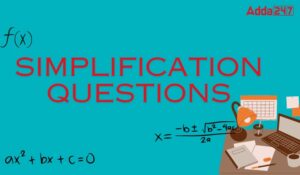Directions (1-5): Study the following table carefully and answer the following questions related to it.
|
Years
|
Total number of mobiles of a company manufactured in different years (in lakhs)
|
Ratio of good and bad mobiles
G : B
|
|
2001
|
225
|
13 : 2
|
|
2002
|
–
|
16 : 3
|
|
2003
|
325
|
–
|
|
2004
|
381
|
5 : 1
|
|
2005
|
423
|
–
|
|
2006
|
515
|
17 : 3
|
Note: There are some missing data in the table given above. If there is any requirement of these missing data in any question, find them and then proceed.
Q1. What is the average number of good mobiles manufactured by company in the years 2001, 2003 and 2004 together if total number of good mobiles manufactured by company in the year 2003 was 273 lakhs?
(a) 295 lakhs
(b) 261.83 lakhs
(c) 323.67 lakhs
(d) 421.37 lakhs
(e) 442.17 lakhs
Q2. If the bad mobiles in the year 2001 were (200/3)% of bad mobiles in the year 2002, what is the total number of good mobiles in the years 2001 and 2002 together?
(a) 431 lakhs
(b) 475 lakhs
(c) 435 lakhs
(d) 525 lakhs
(e) None of these
Q3. If the difference between total number of good mobiles in the year 2004 and 2005 was 11.5 lakhs then what was the total number of bad mobiles in the year 2005?
(a) 94 lakhs
(b) 125 lakhs
(c) 85 lakhs
(d) 98 lakhs
(e) None of these
Q4. What is the ratio of number of good mobiles in the year 2004 to the number of good mobiles in the year 2006?
(a) 1151 : 1751
(b) 1391 : 2153
(c) 127 : 175
(d) 1270 : 1751
(e) None of these
Q5. The number of bad mobiles manufactured in year 2001 are approximately what percent more or less than the number of bad mobiles manufactured in the year 2003?
(Use the missing data found in Q1. If required)
(a) 27% less
(b) 53% less
(c) 42% more
(d) 53% more
(e) 42% less
Q6. A machine depreciates in value each year at the rate of 10% of its previous value. However, every second year there is some maintenance work so that in that particular year, depreciation is only 5% of its previous value. If at the end of the fourth year, the value of the machine stands at Rs 1,46,205, then find the value of machine at the start of the first year.
(a) Rs 1,90,000
(b) Rs 2,00,000
(c) Rs, 1,95,000
(d) Rs 2,10,000
(e) None of these
Q7. In the university examination last year, Rajesh scored 65% in English and 82% in History. What is the minimum percent he should score in Sociology, which is out of 50 marks (if English and History were for 100 marks each), if he aims at getting 78% overall?
(a) 94%
(b) 92%
(c) 98%
(d) 96%
(e) None of these
Q8. A sold a table to B at a profit of 20%. B sold the same table to C for Rs 75 thereby making a profit of 25%. Find the price at which A bought the table from X.
(a) Rs 30
(b) Rs 40
(c) Rs 50
(d) Rs 60
(e) None of these
Q9. A watch dealer sells watches at Rs 600 per watch. However, he is forced to give two successive discounts of 10% and 5% respectively. However, he recovers the sales tax on the net sale price from the customer at 5% of the net price. What price does a customer have to pay him to buy the watch?
(a) Rs 539.75
(b) Rs 539.65
(c) Rs 538.75
(d) Rs 538.65
(e) None of these
Q10. A pet shop owner sells two puppies at the same price. On one he makes a profit of 20% and on the other he suffers a loss of 20%. Find his loss or gain per cent on the whole transaction.
(a) Gain of 4%
(b) No profit no loss
(c) Loss of 10%
(d) Loss of 4%
(e) None of these
Directions (11-15): What will come in place of question mark (?) in the questions that follow:
Q11. 2¾÷3¾× (125/16)×256=?
(a) 1466 ⅔
(b) 1571 ⅔
(c) 1509
(d) 373 (5/11)
(e) None of these
Q12. 9999 ÷ 99 × 73 + 251 = ?
(a) 6578
(b) 8264
(c) 7624
(d) 5024
(e) None of these
Q13.
(a) 713/653
(b) 65/71
(c) 121
(d) 851/744
(e) 444/545
Q14. 36% of 545 + 32% of 215 – 47% of 1300 = ?
(a) 643
(b) 346
(c) –411
(d) –346
(e) None of these
Q15.√1225÷ ∛343× 45% of 760 = ?
(a) 1170
(b) 1730
(c) 1510
(d) 1710
(e) None of these
You may also like to Read:
- Quantitative Questions for upcoming Banking and Insurance Examinations
- Study Notes of Quantitative Aptitude
- Practice More Data Interpretation Questions
- Quantitative Aptitude Section Strategy











 Simplification Questions For Bank Exams ...
Simplification Questions For Bank Exams ...
 Quantity Comparison Questions for Bank E...
Quantity Comparison Questions for Bank E...
 Mixture & Alligation Questions for B...
Mixture & Alligation Questions for B...







